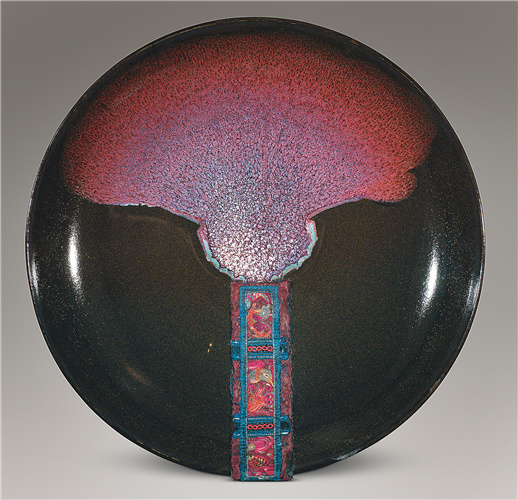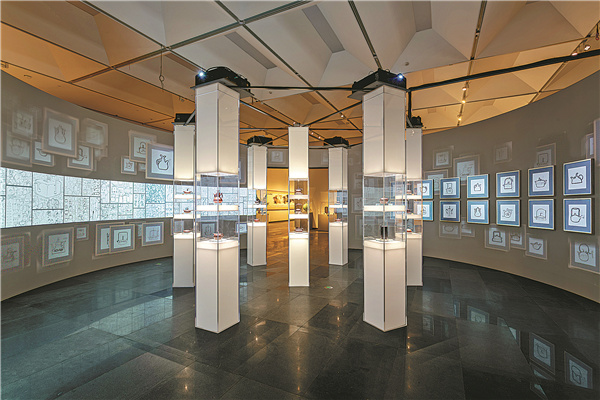 Artist Han Meilin's sculpture Buddha is displayed at Anhui Art Museum in Hefei, Anhui province. It's part of a long-running solo show, which Han regards as a thankful gesture toward the province he views as his "second home". [Photo provided to China Daily]
Artist Han Meilin's sculpture Buddha is displayed at Anhui Art Museum in Hefei, Anhui province. It's part of a long-running solo show, which Han regards as a thankful gesture toward the province he views as his "second home". [Photo provided to China Daily]A veteran artist expresses his gratitude to the province where his creative journey began with a new exhibition.
Han Meilin, the well-known artist, now aged 86, views Anhui province as his "second home".In 1963, Han, then a young teacher at the Academy of Arts and Design, Tsinghua University, was transferred to Anhui to help build a fine arts academy in Hefei, the provincial capital. For the next 22 years, he continued to live and work there, before being transferred back to Beijing in the 1980s.
Han, possibly most widely known for creating the Fuwa mascots for the 2008 Summer Olympics in Beijing, has built a huge body of work through painting, calligraphy, sculpture, design and research of folk arts and crafts.
It was in Anhui where Han started his journey, from a young artist to an established figure in the Chinese art world.
 A ceramic work is displayed at Anhui Art Museum in Hefei, Anhui province. It's part of a long-running solo show, which Han regards as a thankful gesture toward the province he views as his "second home". [Photo provided to China Daily]
A ceramic work is displayed at Anhui Art Museum in Hefei, Anhui province. It's part of a long-running solo show, which Han regards as a thankful gesture toward the province he views as his "second home". [Photo provided to China Daily]"Anhui is the place that fuelled my creativity and took my work to a higher level. I felt like I was an airplane taking off at full power," Han says.
In a thankful gesture toward the province, Han is presenting an eponymous solo exhibition at Anhui Art Museum in Hefei, which is among several inaugural shows at the new museum that opened to the public on May 25.
The long-term exhibition unfolds the full spectrum of Han's work, with paintings, calligraphy, ceramics, stamp designs, zisha (or purple clay) teapots, metalwork and other folk arts. It reflects the diversity and vitality of his creations, as well as his optimism and belief in unremitting work, whether he was experiencing a good or bad time.
 Artist Han Meilin's ink painting Horses is displayed at Anhui Art Museum in Hefei, Anhui province. It's part of a long-running solo show, which Han regards as a thankful gesture toward the province he views as his "second home". [Photo provided to China Daily]
Artist Han Meilin's ink painting Horses is displayed at Anhui Art Museum in Hefei, Anhui province. It's part of a long-running solo show, which Han regards as a thankful gesture toward the province he views as his "second home". [Photo provided to China Daily]The exhibition also reviews how Han sourced inspiration from Anhui's cultural heritage, through which he gradually accumulated an art vocabulary of his own. His years in Anhui allowed him an extensive exposure to the rich folk art and crafts of the province.
During a yearlong stay in Jieshou, he was immersed in the area's three-color pottery art, a tradition that can be traced to the Tang Dynasty (618-907), which features simple and primitive patterns. He also researched other handicrafts, including paper-cutting in Fuyang and tiaohua cross-stitch work in Hefei.
In the following decades, Han was able to blend these elements, endorsing ordinary people's takes on life and beauty, in his creation of various forms.
It was also at his humble home in Anhui during those years that Han began to explore one of his signature works, Tianshu (Heavenly Script). He created a calligraphy style by infusing the forms of the characters and patterns on archaic bronze and folk items.
 Artist Han Meilin's sculpture Buddha, a ceramic work and ink painting Horses are displayed at Anhui Art Museum in Hefei, Anhui province. It's part of a long-running solo show, which Han regards as a thankful gesture toward the province he views as his "second home". [Photo provided to China Daily]
Artist Han Meilin's sculpture Buddha, a ceramic work and ink painting Horses are displayed at Anhui Art Museum in Hefei, Anhui province. It's part of a long-running solo show, which Han regards as a thankful gesture toward the province he views as his "second home". [Photo provided to China Daily]Zhao Li, a professor at the Central Academy of Fine Arts and curator of several of Han's previous exhibitions, says Han's works show that "he is always at the forefront of life, deeply rooted in tradition, bridging the past and the present", and, as such, he is able to reinvent the forms of his creation.
"While he is working, he is as vigorous and creative as a young person," Zhao says.
Han says that in Anhui he met many people with whom he cemented friendships during difficult times, which is why he still feels gratitude for his years there.
He says the current exhibition is not only an opportunity for a "reunion with these friends", but also a promise to them that he will keep working.
"I am, and will be, marching on," Han says.